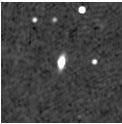Imaging Flanking Fields
Overview
The ability to image flanking fields will be introduced in CASA v. 3.0.0. For the purposes of this guide, flanking fields are the locations of neighboring radio sources that can contribute significant, confusing signal to your science target. The confusing signal is introduced through sidelobes, which are local maxima of the point response function, or beam, of the array.
There are two angular scales that are important to the discussion: the synthesized beam and the primary beam. The synthesized beam is the effective angular resolution of the array and is determined by the longest baselines, or telescope separations. The primary beam is the angular resolution of a single telescope in the array, and is determined by its physical diameter. The response to radio sources outside the primary beam is very poor, and, unless they are peculiarly bright, such radio sources will contribute negligible confusing signal. The scale of both synthesized beam and the primary beam can be approximated by the Rayleigh criterion.
To achieve the highest quality image of the science target, any neighboring radio sources should be imaged and deconvolved to reduce the sidelobe contribution. One approach is to image a very large field around your science target; however, long baseline configurations require small pixels to sample the synthesized beam, and the number of pixels required to map the primary beam becomes inconveniently large. To illustrate, the following table lists the image sizes required to map the VLA primary beam at observing frequency 1.4 GHz and for the four primary array configurations. The primary beam at this frequency is ~32'.
| Configuration | A | B | C | D |
|---|---|---|---|---|
| Clean Beam(") | 1.4 | 4.6 | 15 | 50 |
| Pixels | 4200 | 1300 | 380 | 120 |
The upshot is that VLA A-array and B-array observations would require very large, mostly empty images to map the primary beam. It's potentially faster and certainly lighter on disk space to make postage stamp images, or smaller images centered at the science target and flanking fields that contain bright radio sources.
Determining the Location of Flanking Fields
There are two approaches to determining the location of flanking fields. The first is to make a tapered image with large pixels and map the primary beam at artificially poorer angular resolution. The positions of confusing sources can be read off using the CASA viewer.
The second approach is to use the on-line NVSS catalog. For this tutorial, we'll look at the science target NGC 3079, an edge-on galaxy with kiloparsec-scale, minor-axis radio lobes.
The location of flanking fields is determined in two steps: (1) generating an NVSS postage stamp image to identify potential confusing radio sources, and (2) using the NVSS catalog to look up the coordinates of the confusing sources.
NVSS Postage Stamp Image Server
First, use the postage stamp image server to generate an NVSS image of radio sources surrounding NGC 3079. Example inputs to the form are shown in the figure below, and the result is shown in the figure at right.
Alternatively, one could specify "FITS" for the image type, and the coordinates of the confusing sources could be read using a FITS image viewer.
From inspection of the postage stamp image, there are 5 radio sources to be imaged including NGC 3079. We'll use the NVSS catalog to get their coordinates.
NVSS Catalog
Appropriate inputs for the NVSS Catalog Browser are shown in the figure below.
The results of this search are provided in the following table. Sources fainter than 10 mJy were removed, and the results are sorted in order of increasing distance from the search center.
| RA(2000) | Dec(2000) | Dist(") | Flux(mJy) | Notes |
|---|---|---|---|---|
| 10 01 57.82 | +55 40 48.5 | <2 | 769.4 | NGC 3079 Nucleus |
| 10 01 58.71 | +55 39 33.3 | 74 | 52.0 | Disk of NGC 3079 |
| 10 01 55.53 | +55 42 04.9 | 80 | 44.0 | Disk of NGC 3079 |
| 10 00 58.93 | +55 40 56.7 | 498 | 56.6 | Nearby radio source |
| 10 02 09.96 | +55 51 26.9 | 648 | 19.7 | Nearby radio source |
| 10 02 45.35 | +55 51 25.2 | 754 | 38.6 | Nearby radio source |
| 10 01 21.07 | +55 53 55.8 | 847 | 551.4 | Nearby radio source |
All of the sources associated with NGC will comfortable image onto one field; the neighboring sources will require the use of flanking fields.
--Jgallimo 15:06, 12 November 2009 (UTC)


